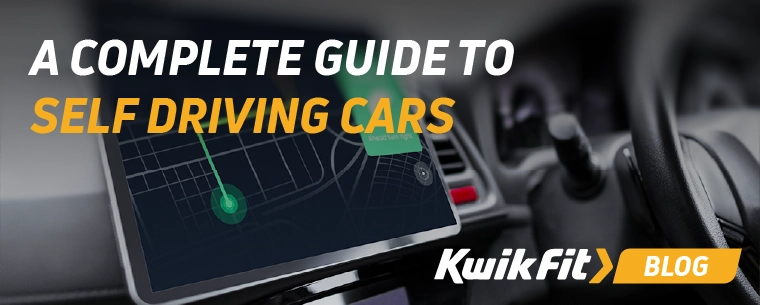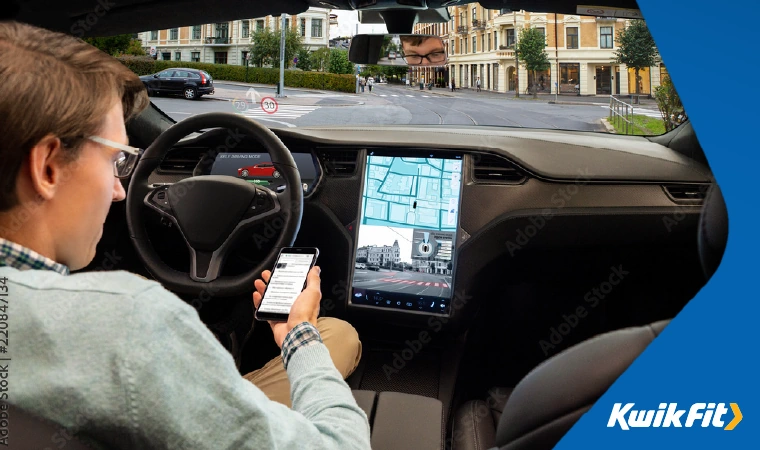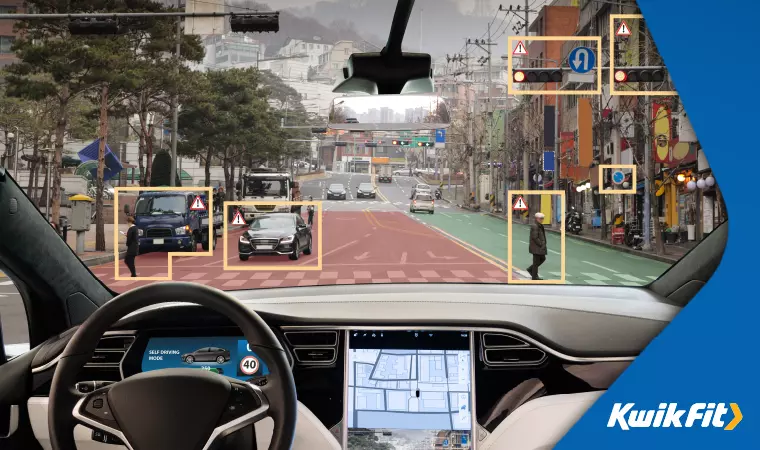A Complete Guide to Self-Driving Cars
Jack Dreyer | Wednesday 9th October 2024 4:00pm

Once a distant dream of science fiction, self-driving cars (or ‘autonomous vehicles’ as they are increasingly known) have become a purchasable reality in recent years — taking motorists’ imaginations (and wallets) by storm.
Back in 2019, there were already 31 million vehicles with at least some level of automation in operation across the globe. But, by the end of 2024, it is estimated that this number will exceed 54 million. With advancements in technology, more and more vehicles are equipped with autonomous features designed to make driving safer, easier, and more efficient. So, don’t be too surprised if you see a car without a driver pull up next to you at traffic lights in the next few years…
Since self-driving cars are relatively new (as a mechanical reality and not a sci-fi motif, that is) , there’s still some confusion and mystery about how they work. So, in this blog, the experts at Kwik Fit will guide you through vehicular automation, its popularity, benefits, and functionality.
Read on to get started.
What are self-driving cars?
Let’s start with the basics. A self-driving car is any vehicle that operates without human input owing to a combination of sensors, camera, artificial intelligence, and radar. By using advanced technology to quickly gather and respond to stimuli, self-driving cars are able to mimic the decisions and manoeuvres made by a human when driving, successfully driving safely along roads.
In the UK, there are currently none of these autonomous vehicles allowed on the roads. However, since the Automated Vehicles Act came into force (more on this later), self-driving vehicles are set to be on roads by 2026.
Levels of automation
It’s important to understand that ‘self-driving car’ is a blanket term that refers to multiple different types of automated vehicle, each with differing levels of automation.
- Level 0: No automation. There may be some electronic systems in place, but these must be activated by drivers manually.
- Level 1: Driver assistance. A couple of assistive automated technologies such as lane assist, parking assistance, or adaptive cruise control.
- Level 2: Partial driver assistance. This involves ADAS (Advanced Driver Assistance Systems) which can help drivers be more hands-off but still require supervision.
- Level 3: Conditional driving automation. The car can be fully autonomous when engaged — but only in certain conditions. This involves braking, steering, and accelerating, but the driver must be ready to take full control when the vehicle requests. Currently, no Level 3 vehicles are permitted anywhere in the world.
- Level 4: High driving automation: This is essentially a fully autonomous vehicle, but the self-driving mode is only permitted within certain areas and under certain weather conditions. Speeds can also be limited for self-driving. Level 4 is most commonly used in driverless taxis at the moment.
- Level 5: Full driving automation. Finally, we have a completely automated car that will likely have no need for steering wheels or pedals.

The popularity of self-driving cars in the UK
Worldwide, particularly in the United States, self-driving cars have taken off (not literally — we’re not quite at flying cars yet). However, the UK is exercising caution and is still very much in its testing phase.
There have been a number of self-driving trials across the country — namely in Oxford and London by companies Wayve and Oxa — to assess the safety and performance of these kinds of vehicles. The government is on board with testing, but has high standards — outlining their Code of Practice for those wanting to trial self-driving vehicles in the UK.
While many motorists view self-driving vehicles as a thing of the too-distant future, between 2018 and 2022, the UK self-driving vehicle sector alone generated £475 million of direct investment and created 1,500 new jobs. In fact, there are multiple benefits to the expansion of the self-driving sector, such as:
- Supporting areas impacted by driver shortages
- Providing solutions where driving is dangerous like haulage or mining
How has ADAS turned into self-driving capability?
Up until recently, self-driving cars were not fully recognised by law in the UK. However, that has since changed on account of the 2024 Automated Vehicles Act. As the transport secretary, Mark Harper, said:
‘Britain stands at the threshold of an automotive revolution and this new law is a milestone moment for our self-driving industry, which has the potential to change the way we travel forever.’
Announced in the King’s Speech 2023, the AV Act enables advanced technology to safely drive vehicles on British roads. The law requires self-driving cars to be on the roads under some conditions:
- Self-driving vehicles must achieve a certain level of safety at least as high as careful and competent human drivers
- Self-driving vehicles must also meet rigorous safety checks before being allowed onto roads.
The core reasoning behind this law is safety — in particular, the reduction of deaths and casualties caused by drunk driving, speeding, tiredness, and inattention to the road. The thinking is that automation could help reduce human error, a factor currently responsible for 88% of road collisions.
Crucially, this Act makes some interesting statements about responsibility — primarily that, when an autonomous vehicle is in self-drive mode, drivers cannot be held responsible for how the car drives. Instead, and for the very first time, car manufacturers, software companies, insurance providers, and corporations who sell autonomous vehicles will be responsible for any faults made by self-driving cars.
Since this law has been passed, self-driving vehicles that pass safety testing could be rolled out onto Britain’s roads as early as 2026. We’ll wait and see.
How do self-driving cars work?

With the meteoric rise of Teslas and other electric vehicles, we’ve also seen the similarly meteoric rise of advanced driver assistance systems – even to the point of, possibly, viable self-driving cars. But how do they work, and are they safe?
Let’s find out.
Lower-level self-driving cars rely on ADAS
As we’ve seen above, many of the lower level automated vehicles rely on ADAS as the extent of their automation. Advanced Driver Assistance Systems (ADAS) are the super-futuristic siblings of parking sensors. What started as simple beeps when you reversed too near a tree has turned into a whole host of fully-integrated sensors, cameras, and computers.
The idea behind ADAS was initially to make life much easier for drivers: if you have trouble parallel parking, then the ADAS system can do it for you, parking much faster and more safely than many drivers could achieve. Though this has, of course, come with its fair share of scrapes and dents.
The other big advancement – which was more in-demand in the States due to the far greater level of motorway driving there – has been the actual driving elements like automatic braking and lane assist. These features let you put the car in essential auto-pilot while on a motorway until you need to take action – which results in a much less stressful drive over long distances.
But what about vehicles with higher levels of automation? How do they work?
How higher-level self-driving cars work
A self-driving car works via a central computer taking inputs from various cameras and sensors around the car before using those inputs to make decisions about how to drive.
The software that powers this is usually one that will have been trained on huge image datasets of what other vehicles and vehicle types look like, what common road markings look like, what pedestrians crossing roads look like, and so on.
Often, the computers generate 3D understandings of the world around them that will include a certain distance around them. These can be helpful for understanding obstacles (even if it doesn’t categorise those obstacles correctly) because it’s often useful to be able to be aware that something solid is in front of you.
As technologies advance more and more every year, self-driving cars may also be “connected” to networks or each other to give them even more information to respond to. This connectivity allows the most sophisticated self-driving car models to communicate with other vehicles or even smart infrastructure, like next-generation traffic lights.
Keep you car safe, self-driving or otherwise
Here at Kwik Fit, we’ve made it our mission to ensure that motorists drive away happy, every time. And, at this rate, while it might not be actual humans driving away from our centres soon, we’ll always strive to deliver excellent service.
So, if you’re keen to keep your car roadworthy and in tip-top condition for as long as possible, book in for regular servicing and essential maintenance like a Free Vehicle Safety Check or Free Brake Check at your nearest Kwik Fit.
In the meantime, don’t get left in the dust by constantly-evolving car technology; keep up to date with all the latest advancements as explained on the Kwik Fit blog.
Any facts, figures and prices shown in our blog articles are correct at time of publication.
Featured Articles
Is it Illegal to Drive With One Headlight?
Saturday 19th July 2025
Wondering if it’s illegal to drive with one headlight? Learn about the safety risks and penalties of illegal blown bulbs and why you should fix them promptly.
Air Con in EVs & Hybrids: Experts Answer Your Questions
Monday 30th June 2025
Does air con drain EV batteries? Can you use the air con while charging an electric car? Find out the answers to these questions & more from Kwik Fit’s experts.
Why Is Your Car Making a Noise? Fixes & Tips
Friday 13th June 2025
When your car starts making unexpected noises, it can certainly be quite disconcerting; it may be nothing to worry about, but here’s what you need to know.









